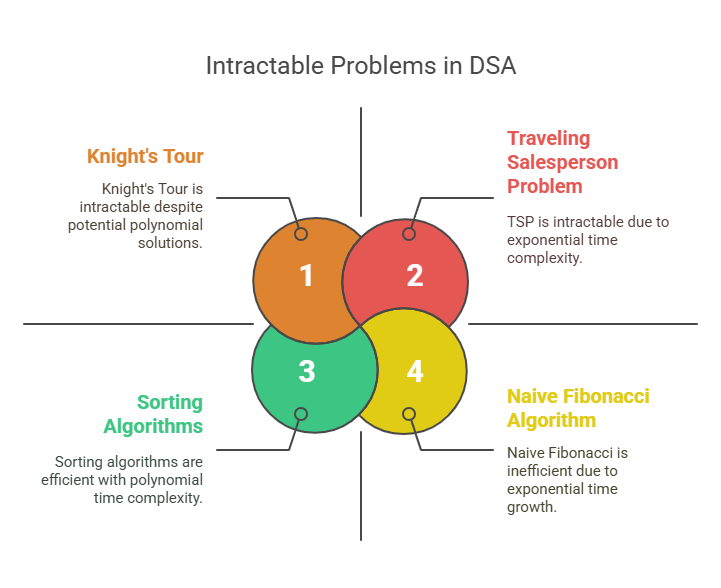Intractable Problems

A key idea in computer science is the concept of intractable problems, which are a class of problems that, while theoretically solvable. Generally speaking, these issues are those for which there is no known polynomial-time algorithm.
Definition and Characteristics of Intractable Problems
Data structures are methodical approaches to organising and retrieving data, while algorithms are sequential processes for completing tasks in a certain amount of time. In order for an algorithm to be deemed “good,” its efficiency specifically its running time and space usage must be evaluated. An algorithm’s execution time usually grows as the input size does.
Effective and inefficient approaches are generally distinguished by polynomial-time and exponential-time algorithms. Consider an algorithm polynomial if its execution time is O(n^c) for a constant c > 1, where ‘n’ is the input size. An exponential-time method, such O(b^n) with a constant b > 1 (e.g., O(2^n)), is rarely efficient since its running time rapidly increases with input size.
A problem that can be solved in O(n logn) time, for instance, is usually regarded as efficient; for small ‘n’, even an O(n^2) time function may be sufficient. An O(2^n) algorithm, however, quickly becomes unfeasible; for example, a task that takes 2^n microseconds might take 19 microseconds for n=4, an hour for n=31, and a year for n=38. This illustrates why, even when the constant factors are superior at first, faster algorithms eventually outperform asymptotically slow ones.
Understanding data structures and algorithms in Python, including recognising when an algorithm or data structure may malfunction in a particular use case, is fundamental to computer science. Intractable issues are those in which even the quickest algorithms currently in use would require excessive amounts of time to solve, with sufficiently big inputs, effectively making them “failures” from a practical standpoint.
Examples of Intractable Problems
Specifically, list a number of issues as unsolvable:
The Knight’s Tour: The Knight’s Tour is a graph theory unsolvable problem. It requires finding a knight piece’s chessboard path that touches every square once. The problem is among other tough computer challenges like the Travelling Salesperson Problem and Hamiltonian Paths and Cycles.
The Traveling Salesperson Problem: Travelling Salesperson is an unsolvable challenge. Graph algorithms linked to the shortest spanning subtree are discussed. The table of contents and index entries show that this problem is covered on pages 799-800 of the original book.
Hamiltonian Paths and Cycles: Finding pathways or cycles in a graph that visit every vertex exactly once is known as a Hamiltonian path or cycle.
Because the most well-known algorithms for addressing these problems have exponential time complexities that is, the time needed to discover a solution increases exponentially with the quantity of the input they are regarded as unsolvable.
Illustrating Exponential Running Time with a Code Example:
We may demonstrate the idea of exponential running time, which is a characteristic of intractability, using a badly designed recursive algorithm, even if truly intractable issues (by definition) do not have efficient code solutions. Given its O(g^n) duration in its naive recursive form, the Fibonacci algorithm is a well-known example that is frequently used to illustrate the “beauty and pitfalls” of recursive algorithms. The fact that algorithms may run “a lot slower than expected, or worse, you will run out of stack space” is a clear caution to programmers about the dangers of utilising recursion without taking its implications into account.
Example:
def fibonacci(n):
if n == 0:
return 0
elif n == 1:
return 1
else:
return fibonacci(n - 1) + fibonacci(n - 2)
# Example Usage
n = 10
result = fibonacci(n)
print(f"The {n}th Fibonacci number is: {result}")Output:
The 10th Fibonacci number is: 55The data in this pseudocode is based on the widely recognised computer science concepts of recursive algorithms and the Fibonacci sequence, and it aligns with the debate that mention the Fibonacci method pointing out the drawbacks of recursion.
Explanation of Exponential Complexity in the Naive Fibonacci Example:
Calculating Fibonacci(n) in this naive recursive approach necessitates calculating Fibonacci(n-1) and Fibonacci(n-2). Further recursive calls are made by each of these in turn. A quickly growing tree of calls is produced as a result. Fibonacci(5) requires Fibonacci(3) and (4). Fibonacci(4) requires (2) and (3). Take note Fibonacci(3) is calculated more than once. The exponential increase in calculation time is caused by this overlapping subproblem structure, in which the same subproblems are computed repeatedly. With ‘n’, operations expand exponentially. Inefficiency can exhaust a thread’s stack capacity, causing a stack overflow and process shutdown.
Despite the exponential temporal complexity of the naive recursive Fibonacci sequence (O(1.618^n) or O(g^n), where g is the golden ratio), the issue can be resolved. In polynomial time, an iterative strategy like dynamic programming or preserving the final two numbers can solve it well. The example demonstrates the kind of ineffective recursive design that can result in exponential complexity, which is comparable to what happens when brute-force or naive recursive solutions are tried to solve truly intractable issues. Programmers can identify when an algorithm’s intrinsic complexity (such as for intractable problems) or a bad implementation decision (such as naive recursive Fibonacci) results in unsatisfactory performance by being aware of this distinction.
Conclusion
In conclusion, problems that cannot be solved with efficient (polynomial-time) algorithms and that cannot be solved with naive or brute-force approaches result in exponential running times that are impractical for even moderately sized inputs are considered intractable.
